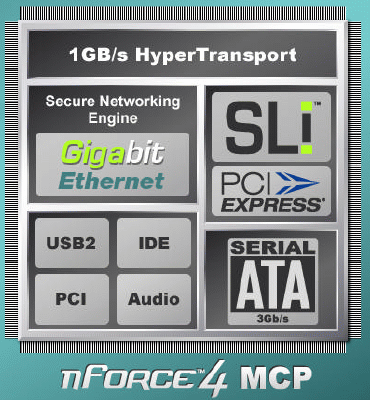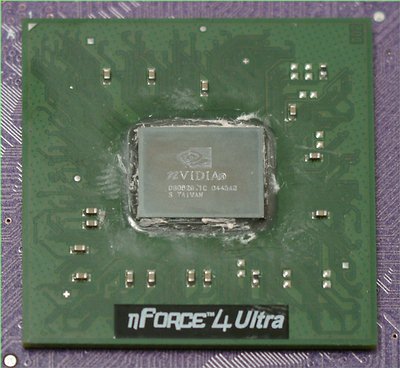 |
||
|
||
| ||
The first generation – nForce3 (nForce3 150) – was not that impressive in functionality. As all chipsets for AMD64 processors offer approximately the same performance, these boards had nothing left to boast of. The company exploited the nForce authority, because of the lack of such functions as DASP and SoundStorm (which actually ensured NVIDIA's success on the chipsets market). There followed the nForce3 250 series, which didn't win by one length (as in times of nForce2), but was still equal among the best. The present migration to the new industry standard – PCI Express – has led to the changed number, so that the improved nForce3 250 series is now called nForce4. Number four in this name is closely related to another "sweet" name, which is almost in the limelight of computer press – SLI. NVIDIA nForce4 series chipsets
The new generation of chipsets from this company is represented by three products. The basic modification is "simply" called nForce4, the modification with advanced functionality – nForce4 Ultra, and finally the topnotch modification with intuitive name – nForce4 SLI.  The flowchart above shows characteristic features of the top product in this series, so we'll just describe the functionality of this chipset and then start the subtraction job. So, the nForce4 SLI provides the following functions:
The nForce4 Ultra chipset differs from the nForce4 SLI only by the lack of SLI support (there can be only one PCIEx16 graphics slot), and besides, the basic modification works only with SATA150 drives and lacks a hardware firewall. Now let's have a closer look at some of the features offered by the nForce4 series.  HT bus (to the processor) properties are the ultimate ones among the competitors, even the current rates (1 GHz, 16/16 bit) are highly excessive, so they will hardly grow in future, and certainly no one will lower them now. As other firstborns with PCI Express support, the nForce4 series has the PCIEx16 graphics interface instead of AGP, the key feature in the nForce4 SLI being an option to "redistribute capacities" for dual video cards operation. By the way, can chipsets from other manufacturers provide SLI? You already know from our articles that it's theoretically possible. But VIA, for example, prefers to shun the direct question and suggests to wait and see how the situation will develop. So, the only official platform for SLI is the nForce4 SLI chipset (desktop solutions from this company). The nForce4 functions, which are traditionally referred to southbridge, are also up to the mark, it has made another step forward. Support for expansion cards is expanded with PCIEx1 slots (there are still no cards of this format on the market, though), the number of USB 2.0 ports is increased to 10 (the other manufacturers "froze" at 8). The unique disk controller, which can organize RAID from hard disks with different interfaces, now supports 4 storage devices (you would have needed an external PHY controller for the two of them) with SATA II rates (3 Gbit/sec) and the corresponding enhanced functionality like NCQ (command queuing) – the matter depends on hard disks now. (You should remember though that the latter is the prerogative of nForce4 Ultra and SLI.) Nevertheless, the pure SATA II rate will not be required in the nearest future. Besides, the two channels supporting 4 ATA133 devices are retained, this is good news for those who own many devices of this standard. NVIDIA also (the only one of the market) offers an integrated gigabit network MAC controller. It was a justified solution before the appearance of PCI Express, because connecting a gigabit network adapter to PCI bus (there were no other options in desktop systems) could limit the throughput. However, even the PCIEx1 throughput is more than enough for this purpose, so most chipset manufacturers (including Intel and VIA) preferred to leave Gigabit Ethernet up to external controllers with PCI Express interface, especially as it will be cheaper than a chipset-integrated MAC and a still necessary external PHY. NVIDIA highlights the attractiveness of this solution by its partially hardware firewall function – ActiveArmor. Integrated TCP/UDP packet filtering unit relieves the CPU of a considerable part of traffic filtering work on the hardware level. And the software firewall, simple-to-operate even for inexperienced users, protects the system from Internet attacks, some viruses, etc. However the >70% CPU load claimed by the manufacturer (without hardware firewall) looks very doubtful and can be correct only in case of focused distributed attack on a given computer or a firewall with ineffective code. Thus, ActiveArmor seems a nice addition for a customer, but it's certainly not the high-priority factor for choosing a system, all the more so as the firewall hardware support is available only in nForce4 Ultra/SLI, while owners of the basic modification of the nForce4 will get just a software product, one of many on the market. One can consider the following issues as disadvantages of the NVIDIA chipset series: the 8-channel AC'97 audio (instead of High Definition Audio support) and the lack of RAID modes, more complex than 0+1. However, the nForce4 is still the most function-rich chipset of the already announced ones on the market, and its Ultra and especially SLI modifications offer unique functionality. Performance testsTestbed configuration:
Software:
Test results
So, we are going to compare a production sample of the motherboard on nForce4 Ultra (there is no reason to believe that nForce4/SLI will differ from the Ultra chipset, all other components being equal) and two engineering samples of motherboards on other chipsets for AMD64 supporting PCI Express. We traditionally start with low level memory tests in RightMark
Memory Analyzer. And we can see right away that the novice
is noticeably superior to both chipsets reviewed. The difference
is very big (up to +17% for real memory write rates!), it cannot
be explained by any circumstantial issues such as a slightly increased
FSB frequency of the production motherboard. When we tested memory latency, all our doubts disappeared: nForce4
is certainly faster than ATI and VIA products in these conditions.
What's up? What about our hackneyed phrases about the identical
performance of all the chipsets without memory controllers (they
are integrated into AMD64 processors)?.. Our constant readers
may remember a similar situation.
The reason was in a BIOS option "2T Command Rate", which
couldn't be disabled (it provides more stable operation at higher
memory frequency or in case of a large number of memory modules
installed). Indeed, this BIOS option cannot be modified in both
engineering samples and ECS KN1 Extreme. But it turned out that
the production sample of ECS had it set to high-speed "1T
Command Rate", while manufacturers of the reference boards
decided that stability was of a higher priority. We have recently
examined a production motherboard based on VIA K8T890 from Albatron
(its review is to be published in the nearest future), which allows
advanced management of timings and other memory operation parameters.
The test results of this motherboard in "1T" and "2T"
modes are practically identical to those for ECS KN1 Extreme (nForce4
Ultra) and VIA VT5867A (VIA K8T890) correspondingly. However, in real applications (including the most critical to
memory performance – archivers) the "1T" advantage
over "2T" (it's not that nForce4 outscores competitors!)
is not that considerable, just 2-4%.
Note the unanimity of all SPECviewperf tests that demonstrated the 5-6% advantage of nForce4. Perhaps it's the same "1T/2T" effect (the difference is too large though), or it's not.
Perhaps it's not that simple, because nForce4 results in games are ambiguous. All the chipsets demonstrate approximately the same results in Doom 3 in all modes. And in minimal mode, where the memory speed must theoretically bring victory to nForce4, the other two contenders look even a tad faster.
In Unreal Tournament 2004 nForce4 predictably wins a couple percents in all modes. The most interesting picture is in FarCry: nForce4 is outscored in low resolutions (up to 6%), but in high resolutions in heavy modes it takes up the running. It suggests an idea that NVIDIA (either in chipset drivers or in hidden BIOS options) optimizes performance in graphical applications so that nForce4 looks better in heavy modes (even sacrificing easy synthetic modes). There is also a chance that it's the effect of the chipset unit responsible for SLI (yes, there is officially no such unit in nForce4 Ultra, but on the silicon level... who knows?). So, we'll wait and gather statistics. ConclusionsAt the time of the announcement (and even after they are already in production) the nForce4 series offers the best functionality among discrete chipsets for AMD64 platform. It's a pity this company does not manufacture chipsets for Pentium 4 (however, this situation will change soon) and stopped integrating graphics – I think that nForce4 with integrated video would have been in demand. What concerns the performance of tested solutions, the new NVIDIA chipset does not make any difference, and it shouldn't. The only intriguing issue is its performance in resource-intensive 3D applications, but we'll try to clear up this issue in time. Is this chipset worth running right away to a store for a motherboard based on this chipset? If you have been waiting to upgrade to PCI Express and you don't need integrated video, the answer is yes, there will be nothing more interesting in the nearest future. On the other hand, if you already have an AMD64 based system, there is absolutely no reason for an immediate upgrade: you will get neither higher performance nor better functionality (for these days).
However, all these reasons don't matter, if you have read this article in search of SLI. Indeed, as far as we know, using a couple of NVIDIA accelerators provides considerable gain. So if you are assembling an ultimatistic gaming computer, a motherboard on nForce4 SLI is definitely your choice, you will hardly regret it.
Write a comment below. No registration needed!
|
|
Platform · Video · Multimedia · Mobile · Other || About us & Privacy policy · Twitter · Facebook
Copyright © Byrds Research & Publishing, Ltd., 1997–2011. All rights reserved.